Fire scar characteristics in two tropical montane conifer species from central Mexico
Jesús Eduardo Sáenz-Ceja A B C , Miguel Martínez-Ramos B , Manuel E. Mendoza C and Diego R. Pérez-Salicrup B *A Unidad de Posgrado, Posgrado en Ciencias Biológicas, Universidad Nacional Autónoma de México, Campus Ciudad Universitaria, Coyoacán, Mexico City 04510, Mexico.
B Instituto de Investigaciones en Ecosistemas y Sustentabilidad, Universidad Nacional Autónoma de México, Campus Morelia, Michoacán 58190, Mexico.
C Centro de Investigaciones en Geografía Ambiental, Universidad Nacional Autónoma de México, Campus Morelia, Michoacán 58190, Mexico.
International Journal of Wildland Fire 31(7) 684-692 https://doi.org/10.1071/WF21110
Submitted: 5 August 2021 Accepted: 10 May 2022 Published: 25 May 2022
© 2022 The Author(s) (or their employer(s)). Published by CSIRO Publishing on behalf of IAWF. This is an open access article distributed under the Creative Commons Attribution-NonCommercial-NoDerivatives 4.0 International License (CC BY-NC-ND)
Abstract
Fire scar analysis is a fundamental tool for reconstructing fire regimes in conifer forests. However, little is known about fire scar properties in tropical montane conifers, where some assumptions limit dendroecological research. These include that fir species do not exhibit external fire scars and that pines without external fire scars have not experienced past fires. This study describes fire scar patterns in two conifer species growing in Mexican temperate forests: sacred fir (Abies religiosa) and smooth-bark Mexican pine (Pinus pseudostrobus). We extracted cross-sections from 110 trees and measured tree age, basal diameter, bark thickness, fire scar size and seasonality, the number of scars per tree, years and basal diameter from pith to the first scar, and the proportion of external and buried fire scars. Most trees had three fire scars, which appeared during the dry season after the first 15 years measured from the pith. Old and large-diameter trees did not have more fire scars, but the time between fire scars influenced fire scar closure in sacred firs. Bark thickness and the proportion of visible and buried fire scars were similar in both species. Our results suggest that the absence of visible fire scars in smooth-bark Mexican pines does not imply the absence of fire, and sacred firs can exhibit external fire scars like pines.
Keywords: bark thickness, conifer, dendrochronology, fire regime, Monarch Butterfly Biosphere Reserve, tree ring, tropical montane forest, wound closure.
Introduction
Fire is a fundamental ecosystem process that shapes the structure, function, and regeneration of conifer forests (Frelich 2002). Analysis of fire-scarred trees is the most used method to reconstruct fire regime properties such as return interval, seasonality, extent and spatial aggregation (Agee 1993; Yocom-Kent 2014). Fire scars occur when fire damages vascular tissues. Then, trees produce chemical substances that inhibit rot and fungal infections. In some cases, subsequent wound wood tends to bury fire scars gradually (Arbellay et al. 2014). Resin production can inhibit their total closure, which generates exposed fire scars, colloquially known as ‘cat faces’ (Arno and Sneck 1977).
Wound closure of fire scars can take from a few years to decades, depending on the species response (Smith et al. 2016), fire recurrence and size of the fire scars, large scars being more difficult to cover (Baker and Dugan 2013). In addition, trees with thick bark are less susceptible to fire scarring (Hoffmann et al. 2003). Bark thickness can be an adaptation to local fire regimes as species in fire-prone ecosystems generally exhibit thick bark. Still, bark thickness varies across tree species and stem diameter (Lawes et al. 2013).
While sampling fire-scarred trees, researchers try to capture the longest and most complete fire historical record (Swetnam and Baisan 1996; Yocom-Kent and Fulé 2015). Consequently, sampling sites are frequently limited to areas that contain visible fire scars (Fulé et al. 2003). Furthermore, as old and large trees tend to have more fire scars (Gutsell and Johnson 1996), trees with multiple external fire scars are sampled over those with buried fire scars (Farris et al. 2013).
Moreover, high-elevation and mesic forests are assumed not to contain trees with fire scars because these ecosystems tend to be associated with stand-replacement fire regimes (Agee and Krusemark 2001; Guyette et al. 2006). However, in some regions or species, the absence of visible fire scars does not necessarily imply a lack of past fires (Stephens et al. 2010). For example, in longleaf pine (Pinus pallustris Mill.) and slash pine (Pinus elliottii Engelm.), it is common to find abundant buried fire scars (Stambaugh et al. 2011; Huffman and Rother 2017). In contrast, in most pine species, abundant resin production could hinder the total healing of fire scars (Chano et al. 2015). Hence, if these assumptions are strictly applied, sites or forests that experienced past fires but whose trees have buried fire scars may not be evaluated, limiting our ecological understanding of fire frequency (Yocom-Kent and Fulé 2015).
Montane tropical forests are ecosystems for which interest in reconstructing fire regimes has increased recently, such as those located in the temperate highlands of central Mexico (Sáenz-Ceja and Pérez-Salicrup 2019a). These are relict forests from the last glaciation period and host high pine species diversity (Farjon 1996). Most of the reconstructed fire regimes have focused on pine species (Yocom and Fulé 2012; Cerano-Paredes et al. 2015; Sáenz-Ceja and Pérez-Salicrup 2019b). In contrast, studies on other conifers, such as the Abies species, are very few in these ecosystems because it has been assumed that these experience stand-replacement fires (Rodríguez-Trejo 2008), and forest legacies decay quickly owing to moist conditions (Moreno-Valdez et al. 2018).
Sacred fir (Abies religiosa [H.B.K.] Schlecht et Cham) and smooth-bark Mexican pine (Pinus pseudostrobus Lindley) are two conifer species widely distributed in temperate forests in central Mexico. Field-based observations and two recent fire chronologies confirm the possibility of reconstructing fire regimes by analyzing fire scars in trees of both species (Sáenz-Ceja and Pérez-Salicrup 2019b; Cerano-Paredes et al. 2021). However, little is known about the characteristics of fire scars in samples obtained from the two species, information that could be useful when conducting field sampling in dendroecological research.
The main objective of this study was to characterize fire scar patterns in A. religiosa and P. pseudostrobus trees. First, we describe fire-scarred tree properties such as age, stem diameter, and bark thickness. Second, we focus on the following fire scar properties: seasonality, size, number of scars per tree, age and basal diameter to first fire scar, and proportion of external and buried fire scars. Finally, we assess the relationships between (1) bark thickness and stem diameter and tree age; (2) number of fire scars with tree age, stem diameter, and bark thickness; (3) fire scar size and basal diameter; and (4) the proportion of external and buried fire scars with fire scar size, number of years between fires and bark thickness.
Methods
Study area
This study was conducted in the Monarch Butterfly Biosphere Reserve (MBBR), located within the boundaries of the states of Mexico and Michoacán, within the Trans-Mexican Volcanic Belt (TMVB), in central Mexico. This protected area hosts the overwintering sites of monarch butterflies (Danaus plexippus Linnaeus), which arrive annually from forests in Canada and the United States and overwinter in the MBBR from November to March (Urquhart and Urquhart 1977). The MBBR covers 56256 ha and occupies the Sierras Chincua, Campanario, Chivati-Huacal and Cerro Pelón, and an external portion located in the northeast known as Cerro Altamirano (Fig. 1).
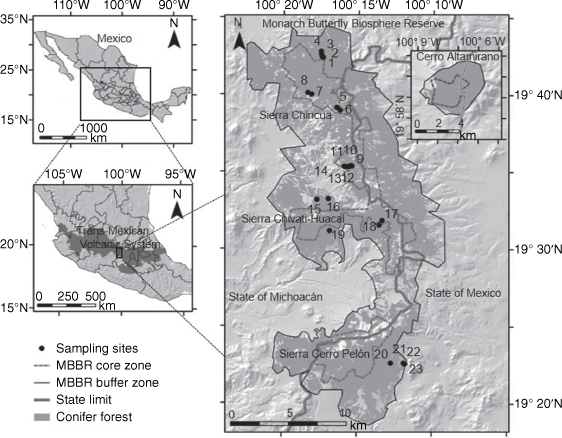
|
The reserve is characterized by rugged topography, consisting of lava flows and volcanic cones; the altitude ranges between 2200 and 3640 m. The climate is semi-cold in the northern portion, and temperate-subhumid in the southern part (García 1997; Ramírez-Ramírez 2001). Conifer forests are the main vegetation cover, of which 12% is dominated by Abies religiosa (3150–3300 m), 27% is co-dominated by both species (2850–3150 m), and 33% is covered by Pinus pseudostrobus (2400–2850 m). The remaining vegetation types include oak forests, montane cloud forests, grasslands and tropical deciduous forests (Ibarra-Manríquez and Cornejo-Tenorio 2007; Sáenz-Ceja and Pérez-Salicrup 2020).
Although an official fire suppression policy has been in place since the current extent of the MBBR was decreed in 2000, fires are common in the conifer forests, generally associated with agricultural activities, improvement of pasture growth, road clearing, and campfires (Martínez-Torres et al. 2015). Sacred fir, smooth-bark Mexican pine, and mixed fir–pine forests typically experience frequent (2–3 years mean fire-return intervals), low-intensity, and small fires, whose occurrence has not decreased since the decree creating the MBBR (Sáenz-Ceja and Pérez-Salicrup 2019b).
Collection and dating of fire scars
Throughout the MBBR, we established 23 sampling plots (Fig. 1), located on stands dominated by A. religiosa, P. pseudostrobus, or co-dominated by both species (see Supplementary Table S1). The sampling plots were selected according to testimonies of landowners who indicated the location of sites that experienced fires. Within each plot, we recorded the presence of fire-scarred stumps and logs with visible and buried fire scars, following Huffman and Rother (2017). The latter found that targeting only trees with evidence of external scarring is not effective when buried fire scars are abundant. Owing to environmental restrictions on sampling living trees, only logs or stumps were sampled, including logs derived from a severe winter storm in 2016 that caused high tree mortality (Brower et al. 2017).
We identified the species of each log or stump, measured the basal diameter and collected one cross-section per tree with a chainsaw. We obtained 110 cross-sections, 60 from A. religiosa and 50 from P. pseudostrobus; 66 cross-sections came from stumps and 44 from logs. Of these, 46% showed rotten wood and very deep fire scars. All samples were dried, sanded and polished following dendrochronological standards (Stokes and Smiley 1968; Speer 2010).
We cross-dated all cross-sections, building skeleton plots for each sample whose pattern of thin rings was compared with a local master chronology (Carlón-Allende et al. 2016). These skeleton plots were useful for cross-dating stumps. Fire years were identified, characterized by charcoal traces and woundwood formation (Gutsell and Johnson 1996). We also measured bark thickness at seven equidistant points of the cross-sections with an electronic Vernier and estimated the relative bark thickness (ratio of bark thickness to stem radius) of each fire scar sample (Schafer et al. 2015)
We determined the number of fire scars and the years or basal diameter from pith to the first fire scar for each tree. The seasonality of fire scars was recorded according to their position within the annual growth ring, classified as follows: D, dormancy; EE, earlywood; ME, middle of earlywood; LE, late earlywood; and L, latewood (Baisan and Swetnam 1990). Following Cerano-Paredes et al. (2015), we determined fire scars occurring during the dry season (March–June) by summing EE + ME fire scars and those occurring in the wet season (July–October), which corresponded to LE fire scars.
We also calculated the proportion of external and buried fire scars in both species (Fig. 2). As our samples included individuals from several diameter categories, the size of fire scars was estimated by dividing the arc length of each fire scar by the circumference of the tree with that fire scar (Marschall et al. 2014).
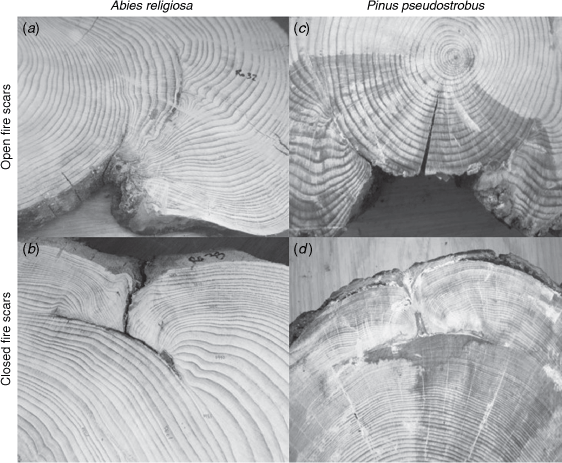
|
Data analyses
All statistical analyses were performed in R version 3.4.3, using a 95% confidence level (R Development Core Team 2017). The relationships between the number of fire scars, tree age and basal diameter were tested through linear regressions (lm function). In addition, the relationships between bark thickness, tree age and stem diameter were evaluated with non-linear regressions (nls function). However, as stem diameter can influence bark thickness, we also assessed significant differences in relative bark thickness between species (Schafer et al. 2015). First, we established three diameter categories: 0–30, 30–60, and>60 cm; then, we performed an analysis of variance (aov function) and assessed differences between categories with a Tukey test (TukeyHSD function).
In addition, we assessed the relationship between fire scar size and basal diameter when fire-scarred through a non-linear regression (nls function). Also, significant differences in the frequency of external and buried fire scars for both species were evaluated with an independence test (chisq.test function). Finally, we assessed whether the proportion of external or buried scars was influenced by the size of fire scars, number of years between fire scars and bark thickness using generalized non-linear models (gam function).
Results
The approximate age of Abies religiosa trees ranged from 24 to 166 years and averaged 83 years, showing a symmetrical distribution aggregated around the mean, in which 63% of trees had an age between 60 and 90 years. The approximate age of Pinus pseudostrobus ranged from 32 to 130 years, averaging 78 years, and had a right-skewed distribution in which 50% of trees had an age between 60 and 115 years (Fig. 3a). A. religiosa trees had basal diameters varying from 19 to 105 cm, with a mean of 62.8 cm, and a left-skewed distribution. The basal diameter in P. pseudostrobus trees ranged from 20 to 92 cm, averaging 47.7 cm, and had right-skewed and dispersed age distribution, in which 50% of trees had diameters ranging 40–65 cm (Fig. 3b).
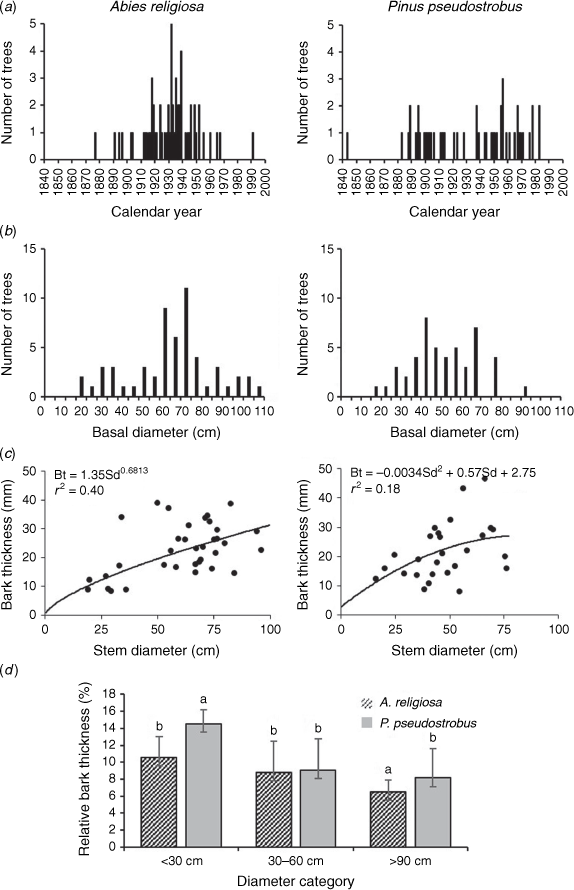
|
Bark thickness averaged 22.3 mm in A. religiosa and 21.7 mm in P. pseudostrobus trees. Bark thickness was influenced by stem diameter in A. religiosa (r2 = 0.40, F = 32.94, P < 0.05) and P. pseudostrobus (r2 = 0.18, F = 5.28, P < 0.05) (Fig. 3c). In contrast, no relationship was found between bark thickness and tree age in both species. Significant differences were found in relative bark thickness between stem diameter categories (F = 12.96, P < 0.05) but not between species (Fig. 3d).
The total number of fire scars identified, including both species, was 326; the oldest dated from 1878 and the most recent from 2015. The seasonality was determined for all fire scars: 68.4% of A. religiosa and 78.5% in P. pseudostrobus belonged to the ME period. Most fire scars appeared during the dry season, 76.7% for A. religiosa and 82.4% for P. pseudostrobus samples (Table 1).
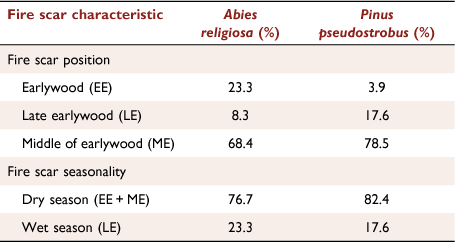
|
The number of fire scars per tree showed a right-skewed distribution in both species, in which 34% of A. religiosa trees and 32% in P. pseudostrobus had one fire scar. The maximum number of fire scars per tree was 11 in A. religiosa and 8 in P. pseudostrobus, but 72% of samples had up to three scars in the former species and 76% in the latter (Fig. 4a). No significant relationship was found between the number of fire scars, tree age, basal diameter and bark thickness in both species.
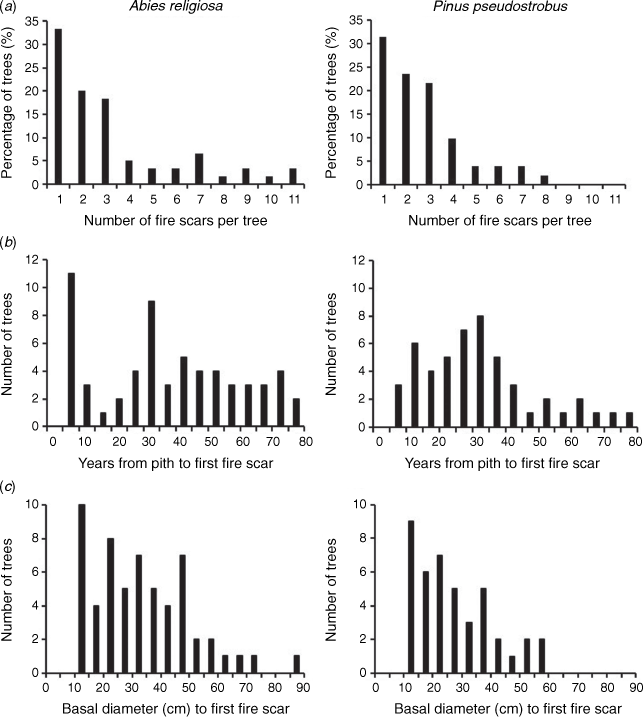
|
The first fire scar appeared within the first 10 years from the pith year in 18% of A. religiosa trees, although the mean was 39 years, whereas in P. pseudostrobus, the mean was 33 years, but 18% of trees had their first scar before 15 years from the pith (Fig. 4b). Furthermore, the first fire scar appeared in trees with a basal diameter greater than 10 cm in both species. Most trees (46% of A. religiosa and 64% of P. pseudostrobus) recorded their first fire scar with basal diameters between 10 and 30 cm (Fig. 4c).
The percentages of external fire scars were similar in both species, 55 and 56% of samples for A. religiosa and P. pseudostrobus, respectively, with no significant differences. The length of the fire scars was significantly, although weakly, correlated with basal diameter in both A. religiosa (r2 = 0.04, t = −2.596, P < 0.05) and P. pseudostrobus (r2 = 0.14, F = −4.404, P < 0.05) (Fig. 5a). Also, no relationship was found between the fire scar size and the number of external and buried scars in both species (Fig. 5b). The number of external fire scars in A. religiosa samples decreased considerably after 10 years without fire scarring (d.f. = 236, t = −4.464, P < 0.05). In contrast, in P. pseudostrobus, the number of external and buried fire scars was independent of the number of years between fire scars (Fig. 5c).
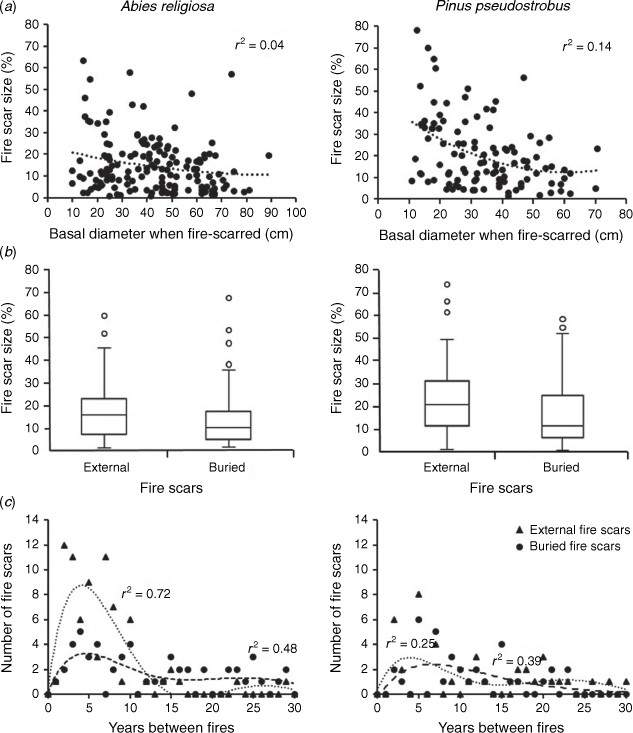
|
Discussion
The forest structure in the MBBR is composed of young conifer populations as few trees were older than 120 years, which reflects a rapid population replacement (Sáenz-Ceja and Pérez-Salicrup 2020). The low proportion of multi-scarred trees is consistent with this population pattern and may explain why most trees have less than four fire scars. This could be a substantial limitation to reconstructing longer fire chronologies in the MBBR; a similar pattern is found in Mexican tropical conifer forests, where fire chronologies do not exceed 150 years (Cerano-Paredes et al. 2015; Cerano-Paredes et al. 2016).
Many fire scar properties are shared by Abies religiosa and Pinus pseudostrobus. For example, most fire scars were formed in the dry season, which is the period yearly with the most fire occurrences in the MBBR (Martínez-Torres et al. 2015). The oldest or largest-diameter trees do not necessarily have more fire scars. This is consistent with findings in ponderosa pine (Pinus ponderosa Douglas ex Lawson), indicating that tree size or age is not a helpful criterion to select fire-scarred samples (Yocom-Kent and Fulé 2015).
Approximately one-fifth of the trees had their first scar from the pith within the first 15 years, contrasting with the results by Baker and Ehle (2001), who suggested a minimum fire-free period of 50 years is necessary for a ponderosa pine tree to survive a fire in the western US. Moreover, the first scar appeared after the tree diameter was larger than 10 cm, implying that smaller trees are more likely to be killed by fire (Guyette and Stambaugh 2004). Many Mexican tropical conifers, such as A. religiosa and P. pseudostrobus, have higher growth rates than trees living in extra-tropical latitudes (Klepac 2001; Méndez-González et al. 2011), which may explain that young trees could resist low-intensity fires. The rest of the trees showed their first fire scar after 15 years from the pith. However, these intervals should not be interpreted as years without fires because a large proportion of trees that experienced fire do not always produce fire scars, as shown in Jeffrey pine (Pinus jeffreyi Grev. & Balf.) (Stephens et al. 2010).
The percentage of buried fire scars was very similar in both species. Unlike the size of fire scars, the only variable that influenced the closure of fire scars was the number of years between fire scars. That was only true for A. religiosa, in which 10 years after the last fire the proportion of external fire scars decreased considerably. This suggests that new tree ring growth can conceal fire scars in A. religiosa trees during this time without scarring. This wound closure time is consistent with that observed in white oak (Quercus alba L.) (1–24 years) (Stambaugh et al. 2017) and shorter than in ponderosa pines (>55 years) (Baker and Dugan 2013). These findings confirm that many fire scars in P. pseudostrobus are buried and not visible, and A. religiosa experiences and records surface fires as external fire scars.
Both A. religiosa and P. pseudostrobus exhibited thick bark, an adaptive trait related to trees growing in sites with frequent and low-intensity fires (Pausas 2015). This pattern was also found in Hartweg’s pine (Pinus hartwegii Lindley) in alpine forests of central Mexico, species that experience a similar fire regime and had an average bark-thickness of 38 mm (González-Rosales and Rodríguez-Trejo 2004; Cerano-Paredes et al. 2016). Similarly, in Douglas fir (Pseudotsuga menziesii Franco) trees, bark was 37% ticker than in white fir (Abies concolor (Gordon et Glendinning) Hildebrand) trees, the second species being less exposed to fires (Zeibig-Kichas et al. 2016).
In terms of forest management, the fire scar properties described in this study in A. religiosa and P. pseudostrobus could help assess how fire affects trees in temperate forests of central Mexico. For example, as trees with a basal diameter larger than 10 cm can survive fire, this information could be relevant when conducting prescribed burns to regulate fire intensity and keep tree densities at desired levels (Guyette and Stambaugh 2004). However, more research is needed, particularly on how an increase in fire frequency and subsequent fire scarring could alter tree stability, making them more vulnerable to windthrow (Cannon et al. 2015). In the case of the MBBR, a potential increase of mortality in fire-scarred sacred fir trees due to windthrow could alter long term the population structure of the species preferred by monarch butterflies for perching.
In the context of dendroecological sampling, it is necessary to evaluate the proportion of trees that record fire in the form of a fire scar and how long those scars are visible, which is particularly important in areas where tree growth is accelerated, and scars can be concealed. Without this information, we could potentially underestimate fire frequency (Stephens et al. 2010). The present study demonstrated that the absence of external fire scars in P. pseudostrobus samples does not necessarily indicate a lack of fires. Indeed, frequent small fires are common in the MBBR. A. religiosa trees can also exhibit external and buried fire scars, which unlocks the opportunity for dendrochronological sampling in other sites dominated by the same or related species in tropical montane conifer forests.
Conclusions
Fire-scarring patterns were very similar in Abies religiosa and Pinus pseudostrobus scarred trees, with up to three fire scars per tree. The first fire scar appeared after the first 15 years from the pith; they are produced in the dry season and could be external or buried, independently of scar size. Larger and older trees do not necessarily have more fire scars, and the absence of multi-scarred trees makes it difficult to build chronologies longer than 150 years. Also, the finding of external and internal fire scars in A. religiosa and P. pseudostrobus has changed previous assumptions about fire-scarring patterns in each species, which has relevance in further dendroecological research on these species and others in similar conifer forests.
Data availability
Data will be available on a reasonable request.
Conflicts of interest
The authors declare no conflicts of interest.
Declaration of funding
The first author acknowledges the support of the Graduate Program for Biological Sciences at Universidad Nacional Autónoma de México and the Consejo Nacional de Ciencia y Tecnología (CONACYT, Mexico) for a scholarship. We also thank the UNAM PAPIIT project IN209716 and CONACYT project 251694 for funding that allowed this research. The supporting source had no involvement in preparing the data or manuscript or the decision to submit for publication.
Supplementary material
Supplementary material is available online.
Acknowledgements
In addition to our funding agencies, the authors thank the MBBR Office for permission to conduct fieldwork, as well as the agrarian authorities of ejidos Chincua, Jesús Nazareno, Santa Ana, El Rosario, El Paso, Vare Chiquichuca, and the indigenous communities Donaciano Ojeda and Crescencio Morales. Special thanks to J. Trinidad Sáenz, Álvaro González, Diego González, Luis Lara and Ignacio Cabrera, who collaborated in the fieldwork. Finally, all authors acknowledge the support of the Eco-garden at the Instituto de Investigaciones en Ecosistemas y Sustentabilidad-UNAM during the drying, sanding and measurement of cross-sections.
References
Agee JK (1993) ‘Fire ecology of Pacific Northwest forests.’ (Island Press: Washington, DC)Agee JK, Krusemark F (2001) Forest fire regime of the Bull Run Watershed, Oregon. Northwest Science 75, 292–306. Available at http://hdl.handle.net/2376/941
Arbellay E, Stoffel M, Sutherland EK, Smith KT, Falk DA (2014) Resin duct size and density as ecophysiological traits in fire scars of Pseudotsuga menziesii and Larix occidentalis. Annals of Botany 114, 973–980.
| Resin duct size and density as ecophysiological traits in fire scars of Pseudotsuga menziesii and Larix occidentalis.Crossref | GoogleScholarGoogle Scholar | 25122653PubMed |
Arno SF, Sneck KM (1977) A method for determining fire history in coniferous forests of the mountain West. Intermountain Forest and Range Experiment Station, General Technical Report INT-42. (USDA Forest Service: Ogden, Utah, USA)
Baisan CH, Swetnam TW (1990) Fire history on a desert mountain range: Rincon Mountain Wilderness, Arizona, USA. Canadian Journal of Forest Research 20, 1559–1569.
| Fire history on a desert mountain range: Rincon Mountain Wilderness, Arizona, USA.Crossref | GoogleScholarGoogle Scholar |
Baker WI, Dugan AJ (2013) Fire-history implications of fire scarring. Canadian Journal of Forest Research 43, 951–962.
| Fire-history implications of fire scarring.Crossref | GoogleScholarGoogle Scholar |
Baker WL, Ehle D (2001) Uncertainty in surface-fire history: The case of ponderosa pine forests in the western United States. Canadian Journal of Forest Research 31, 1205–1226.
| Uncertainty in surface-fire history: The case of ponderosa pine forests in the western United States.Crossref | GoogleScholarGoogle Scholar |
Brower LP, Williams EH, Jaramillo-López P, Kust DR, Slayback DA, Ramírez MI (2017) Butterfly mortality and salvage logging from the March 2016 storm in the Monarch Butterfly Biosphere Reserve in Mexico. American Entomologist 63, 151–167.
| Butterfly mortality and salvage logging from the March 2016 storm in the Monarch Butterfly Biosphere Reserve in Mexico.Crossref | GoogleScholarGoogle Scholar |
Cannon JB, Barrett ME, Peterson CJ (2015) The effect of species, size, failure mode, and fire scarring on tree stability. Forest Ecology and Management 356, 196–203.
| The effect of species, size, failure mode, and fire scarring on tree stability.Crossref | GoogleScholarGoogle Scholar |
Carlón-Allende T, Mendoza-Cantú ME, Pérez-Salicrup DR, Villanueva-Díaz J, Lara A (2016) Climatic responses of Pinus pseudostrobus and Abies religiosa in the Monarch Butterfly Biosphere Reserve, central Mexico. Dendrochronologia 38, 103–116.
| Climatic responses of Pinus pseudostrobus and Abies religiosa in the Monarch Butterfly Biosphere Reserve, central Mexico.Crossref | GoogleScholarGoogle Scholar |
Cerano-Paredes J, Villanueva-Díaz J, Cervantes-Martínez R, Fulé P, Yocom L, Esquivel-Arriaga G, Jardel-Peláez E (2015) Historia de incendios en un bosque de pino de la sierra de Manantlán, Jalisco, México. Bosque 36, 41–52.
| Historia de incendios en un bosque de pino de la sierra de Manantlán, Jalisco, México.Crossref | GoogleScholarGoogle Scholar |
Cerano-Paredes J, Villanueva-Díaz J, Vázquez-Selem L, Cervantes-Martínez R, Esquivel-Arriaga G, Guerra de la Cruz V, Fulé PZ (2016) Régimen histórico de incendios y su relación con el clima en un bosque de Pinus hartwegii al norte del estado de Puebla, México. Bosque 37, 389–399.
| Régimen histórico de incendios y su relación con el clima en un bosque de Pinus hartwegii al norte del estado de Puebla, México.Crossref | GoogleScholarGoogle Scholar |
Cerano-Paredes J, Rodríguez-Trejo DA, Iniguez JM, Cervantes-Martínez R, Villanueva-Díaz J, Franco-Ramos O (2021) Fire history (1896-2013) in an Abies religiosa forest in the Sierra Norte of Puebla, Mexico. Forests 12, 700
| Fire history (1896-2013) in an Abies religiosa forest in the Sierra Norte of Puebla, Mexico.Crossref | GoogleScholarGoogle Scholar |
Chano V, López R, Pita P, Collada C, Soto A (2015) Proliferation of axial parenchymatic xylem cells is a key step in wound closure of girdled stems in Pinus canariensis. BMC Plant Biology 15, 64
| Proliferation of axial parenchymatic xylem cells is a key step in wound closure of girdled stems in Pinus canariensis.Crossref | GoogleScholarGoogle Scholar | 25853802PubMed |
Farjon A (1996) Biodiversity of Pinus (Pinaceae) in Mexico: speciation and palaeo-endemism. Botanical Journal of the Linnean Society 121, 365–384.
| Biodiversity of Pinus (Pinaceae) in Mexico: speciation and palaeo-endemism.Crossref | GoogleScholarGoogle Scholar |
Farris CA, Baisan CH, Falk DA, Van Horne ML, Fulé PZ, Swetnam TW (2013) A comparison of targeted and systematic fire scar sampling for estimating historical fire frequency in south-western ponderosa pine forests. International Journal of Wildland Fire 22, 1021–1033.
| A comparison of targeted and systematic fire scar sampling for estimating historical fire frequency in south-western ponderosa pine forests.Crossref | GoogleScholarGoogle Scholar |
Frelich LE (2002) ‘Forest dynamics and disturbance regimes: Studies from temperate-evergreen deciduous forests.’ (Cambridge University Press: Cambridge)
Fulé PZ, Heinlein TA, Covington WW, Moore MM (2003) Assessing fire regimes on Grand Canyon landscapes with fire scar and fire-record data. International Journal of Wildland Fire 12, 129–145.
| Assessing fire regimes on Grand Canyon landscapes with fire scar and fire-record data.Crossref | GoogleScholarGoogle Scholar |
García E (1997) Climatología de la zona de hibernación de la mariposa monarca en la Sierra Transvolcánica de México, invierno 1991-1992. Serie Varia 1, 5–26.
González-Rosales A, Rodríguez-Trejo DA (2004) Efecto del chamuscado de copa en el crecimiento en diámetro de Pinus hartwegii Lindl. en el Distrito Federal, Mexico Agrociencia 38, 537–544. Available at https://www.agrociencia-colpos.mx/index.php/agrociencia/article/view/347
Gutsell SL, Johnson EA (1996) How fire scars are formed: coupling a disturbance process to its ecological effect. Canadian Journal of Forest Research 26, 166–174.
| How fire scars are formed: coupling a disturbance process to its ecological effect.Crossref | GoogleScholarGoogle Scholar |
Guyette RP, Stambaugh MC (2004) Post-oak fire scars as a function of diameter, growth, and tree age. Forest Ecology and Management 198, 183–192.
| Post-oak fire scars as a function of diameter, growth, and tree age.Crossref | GoogleScholarGoogle Scholar |
Guyette RP, Dey DC, Stambaugh MC, Muzika R (2006) Fire scars reveal variability and dynamics of eastern fire regimes. In ‘Fire in eastern oak forests: delivering science to land managers, proceedings of a conference 15–17 November 2005, Columbus OH’. (Ed. MB Dickinson) pp. 20–39. (USDA Forest Service, Northern Research Station, General Technical Report NRS-P-1: Newton Square, PA, USA)
Hoffmann WA, Orthen B, Vargas do Nascimento PK (2003) Comparative fire ecology of tropical savanna and forest trees. Functional Ecology 17, 720–726.
| Comparative fire ecology of tropical savanna and forest trees.Crossref | GoogleScholarGoogle Scholar |
Huffman JM, Rother MT (2017) Dendrochronological field methods for fire history in pine ecosystems of the southeastern Coastal Plains. Tree-Ring Research 73, 42–46.
| Dendrochronological field methods for fire history in pine ecosystems of the southeastern Coastal Plains.Crossref | GoogleScholarGoogle Scholar |
Ibarra-Manríquez G, Cornejo-Tenorio MG (2007) Plant reproductive phenology in a temperate forest of the Monarch Butterfly Biosphere Reserve, Mexico. Interciencia 32, 445–452. Available at https://www.redalyc.org/pdf/339/33932704.pdf
Klepac D (2001) Research on diameter growth and increment of some Mexican pines. Acta Botanica Croatica 60, 267–276. Available at https://hrcak.srce.hr/160869
Lawes MJ, Midgley JJ, Clarke PJ (2013) Costs and benefits of relative bark thickness in relation to fire damage: a savanna/forest contrast. Journal of Ecology 101, 517–524.
| Costs and benefits of relative bark thickness in relation to fire damage: a savanna/forest contrast.Crossref | GoogleScholarGoogle Scholar |
Marschall JM, Guyette RP, Stambaugh MC, Stevenson AP (2014) Fire damage effects on red oak timber product value. Forest Ecology and Management 320, 182–189.
| Fire damage effects on red oak timber product value.Crossref | GoogleScholarGoogle Scholar |
Martínez-Torres HL, Cantú-Fernández M, Ramírez-Ramírez MI, Pérez-Salicrup DR (2015) Fires and fire management in the Monarch Butterfly Biosphere Reserve. In ‘Monarchs in a changing world’. (Eds K Oberhauser, KN Nail, S Altizer) pp. 179–189. (Cornell University Press: New York)
Méndez-González J, Luckie-Navarrete SL, Capó-Arteaga MA, Nájera-Luna JA (2011) Allometric equations and estimation of aboveground biomass and carbon increments in a mixed plantation of Pinus devoniana Lindl. and P. pseudostrobus Lindl. in Guanajuato, Mexico. Agrociencia 45, 479–491. Available at https://agrociencia-colpos.mx/index.php/agrociencia/article/view/894
Moreno-Valdez ME, Domínguez-Gómez TG, Alvarado MS, Colín JG, Corral-Rivas S, González-Rodríguez H (2018) Contribution and decomposition of leaf litter in temperate forests of the El Salto region, Durango. Revista Mexicana de Ciencias Forestales 9, 70–93.
| Contribution and decomposition of leaf litter in temperate forests of the El Salto region, Durango.Crossref | GoogleScholarGoogle Scholar |
Pausas JG (2015) Bark thickness and fire regime. Functional Ecology 29, 315–327.
| Bark thickness and fire regime.Crossref | GoogleScholarGoogle Scholar |
R Development Core Team (2017) ‘R: A Language and Environment for Statistical Computing.’ (R Foundation for Statistical Computing: Vienna, Austria)
Ramírez-Ramírez MI (2001) Cambios en las cubiertas de suelo en la Sierra de Angangueo, Michoacán y Estado de México, 1971–1994–2000. Investigaciones Geográficas 45, 39–55.
| Cambios en las cubiertas de suelo en la Sierra de Angangueo, Michoacán y Estado de México, 1971–1994–2000.Crossref | GoogleScholarGoogle Scholar |
Rodríguez-Trejo DA (2008) Fire regimes, fire ecology, and fire management in Mexico. AMBIO: A Journal of the Human Environment 37, 548–556.
| Fire regimes, fire ecology, and fire management in Mexico.Crossref | GoogleScholarGoogle Scholar |
Sáenz-Ceja JE, Pérez-Salicrup DR (2019a) The role of fire in the regeneration of conifer forests. Revista Chapingo Serie Ciencias Forestales y del Ambiente 25, 123–139.
| The role of fire in the regeneration of conifer forests.Crossref | GoogleScholarGoogle Scholar |
Sáenz-Ceja JE, Pérez-Salicrup DR (2019b) Dendrochronological reconstruction of fire history in conifer forests in the Monarch Butterfly Biosphere Reserve, Mexico. Fire Ecology 15, 18
| Dendrochronological reconstruction of fire history in conifer forests in the Monarch Butterfly Biosphere Reserve, Mexico.Crossref | GoogleScholarGoogle Scholar |
Sáenz-Ceja JE, Pérez-Salicrup DR (2020) Modification of fire regimes inferred from the age structure of two conifer species in a tropical montane forest, Mexico. Forests 11, 1193
| Modification of fire regimes inferred from the age structure of two conifer species in a tropical montane forest, Mexico.Crossref | GoogleScholarGoogle Scholar |
Schafer JL, Breslow BP, Hohmann MG, Hoffmann WA (2015) Relative bark thickness is correlated with species distribution along a fire frequency gradient. Fire Ecology 11, 74–87.
| Relative bark thickness is correlated with species distribution along a fire frequency gradient.Crossref | GoogleScholarGoogle Scholar |
Smith KT, Arbellay E, Falk DA, Sutherland EK (2016) Macroanatomy and compartmentalization of recent fire scars in three North American conifers. Canadian Journal of Forest Research 46, 535–542.
| Macroanatomy and compartmentalization of recent fire scars in three North American conifers.Crossref | GoogleScholarGoogle Scholar |
Speer J (2010) ‘Fundamentals of tree-ring research.’ (The University of Arizona Press: Tucson, AZ)
Stambaugh MC, Guyette RP, Marschall JM (2011) Longleaf pine (Pinus palustris Mill.) fire scars reveal new details of a frequent fire regime. Journal of Vegetation Science 22, 1094–1104.
| Longleaf pine (Pinus palustris Mill.) fire scars reveal new details of a frequent fire regime.Crossref | GoogleScholarGoogle Scholar |
Stambaugh MC, Smith KT, Dey DC (2017) Fire scar growth and healing rates in white oak (Quercus alba) and the implications of prescribed burning. Forest Ecology and Management 391, 396–403.
| Fire scar growth and healing rates in white oak (Quercus alba) and the implications of prescribed burning.Crossref | GoogleScholarGoogle Scholar |
Stephens SL, Fry DL, Collins BM, Skinner CN, Franco-Vizcaíno E, Freed TJ (2010) Fire scar formation in Jeffrey pine–mixed conifer forests in the Sierra San Pedro Mártir, Mexico. Canadian Journal of Forest Research 40, 1497–1505.
| Fire scar formation in Jeffrey pine–mixed conifer forests in the Sierra San Pedro Mártir, Mexico.Crossref | GoogleScholarGoogle Scholar |
Stokes MA, Smiley TL (1968) ‘An introduction to tree-ring dating.’ (University of Chicago Press: Chicago, IL)
Swetnam TW, Baisan CH (1996) Historical fire regime patterns in the southwestern United States since AD 1700. In ‘Fire effects in southwestern forests: Proceedings of the 2nd La Mesa Fire Symposium’, 29–31 March 1994, Los Alamos, NM. (Ed CD Allen) pp. 11–32. (USDA Forest Service, Rocky Mountain Research Station, General Technical Report RM-GTR-286: Fort Collins, CO, USA)
Urquhart FA, Urquhart NR (1977) Overwintering areas and migratory routes of the Monarch Butterfly (Danaus p. plexippus, Lepidoptera: Danaidae) in North America, with special reference to the western population. The Canadian Entomologist 109, 1583–1589.
| Overwintering areas and migratory routes of the Monarch Butterfly (Danaus p. plexippus, Lepidoptera: Danaidae) in North America, with special reference to the western population.Crossref | GoogleScholarGoogle Scholar |
Yocom LL, Fulé PZ (2012) Human and climate influences on frequent fire in a high-elevation tropical forest. Journal of Applied Ecology 49, 1356–1364.
| Human and climate influences on frequent fire in a high-elevation tropical forest.Crossref | GoogleScholarGoogle Scholar |
Yocom-Kent L (2014) An evaluation of fire regime reconstruction methods. Ecological Restoration Institute. ERI Working Paper 32 (Flagstaff, AZ). Available at https://www.nwfirescience.org/sites/default/files/publications/doc.pdf
Yocom Kent LL, Fulé PZ (2015) Do rules of thumb measure up? Characteristics of fire scarred trees and samples. Tree-Ring Research 71, 78–82.
| Do rules of thumb measure up? Characteristics of fire scarred trees and samples.Crossref | GoogleScholarGoogle Scholar |
Zeibig-Kichas NE, Ardis CW, Berrill JP, King JP (2016) Bark-thickness equations for mixed-conifer forest type in Klamath and Sierra Nevada mountains of California. International Journal of Forestry Research 2016, 1864039
| Bark-thickness equations for mixed-conifer forest type in Klamath and Sierra Nevada mountains of California.Crossref | GoogleScholarGoogle Scholar |


